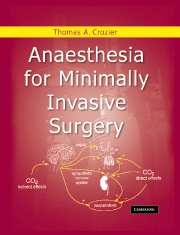Book contents
- Frontmatter
- Contents
- Preface
- Foreword
- Acknowledgements
- 1 Introduction
- 2 Physiology
- 3 Preparing and positioning for laparoscopic surgery
- 4 Monitoring
- 5 Anaesthesia for laparoscopic surgery
- 6 Complications and contraindications of laparoscopic surgery
- 7 Post-laparoscopy pain and pain relief
- 8 Laparoscopic bariatric surgery
- 9 Minimally invasive thoracic surgery
- 10 Laser surgery of the upper aerodigestive tract
- 11 Minimally invasive neurosurgery
- Index
5 - Anaesthesia for laparoscopic surgery
Published online by Cambridge University Press: 21 October 2009
- Frontmatter
- Contents
- Preface
- Foreword
- Acknowledgements
- 1 Introduction
- 2 Physiology
- 3 Preparing and positioning for laparoscopic surgery
- 4 Monitoring
- 5 Anaesthesia for laparoscopic surgery
- 6 Complications and contraindications of laparoscopic surgery
- 7 Post-laparoscopy pain and pain relief
- 8 Laparoscopic bariatric surgery
- 9 Minimally invasive thoracic surgery
- 10 Laser surgery of the upper aerodigestive tract
- 11 Minimally invasive neurosurgery
- Index
Summary
Laparoscopy surgery requires a strategic reassessment and adaptation of anaesthetic management in order to derive the greatest possible benefit from the procedures on the one hand, and to anticipate the specific risks and prevent the complications inherent in the technique on the other. When choosing the anaesthetic, the anaesthetist must be fully aware that the main advantage of these minimally invasive surgical procedures is the shortened recovery period and the intended rapid return of the patient to normal daily life. The patient expects early mobilization, a rapid return to oral feeding and prompt discharge from the hospital – frequently within 24h after an uncomplicated laparoscopic cholecystectomy. This intended fast tracking should not be impeded by postoperative impairment of the patient's recovery by fatigue, lassitude, nausea and vomiting, vertigo or other adverse effects. Even after major operations, such as colectomy, nephrectomy or lymphadenectomy, oral fluids are given on the day of surgery, oral feeding is started on the first postoperative day, and the patient is occasionally discharged from the hospital on the following day.
A further aspect of minimally invasive surgery is the drastic reduction of the time from when, for example, the gall bladder is removed until when the wound is sutured and dressed. Taking the altered time frame into consideration, the anaesthetist can contribute to the smooth handling of the surgical schedule by ensuring short turnover times between the individual patients.
- Type
- Chapter
- Information
- Anaesthesia for Minimally Invasive Surgery , pp. 55 - 74Publisher: Cambridge University PressPrint publication year: 2004



